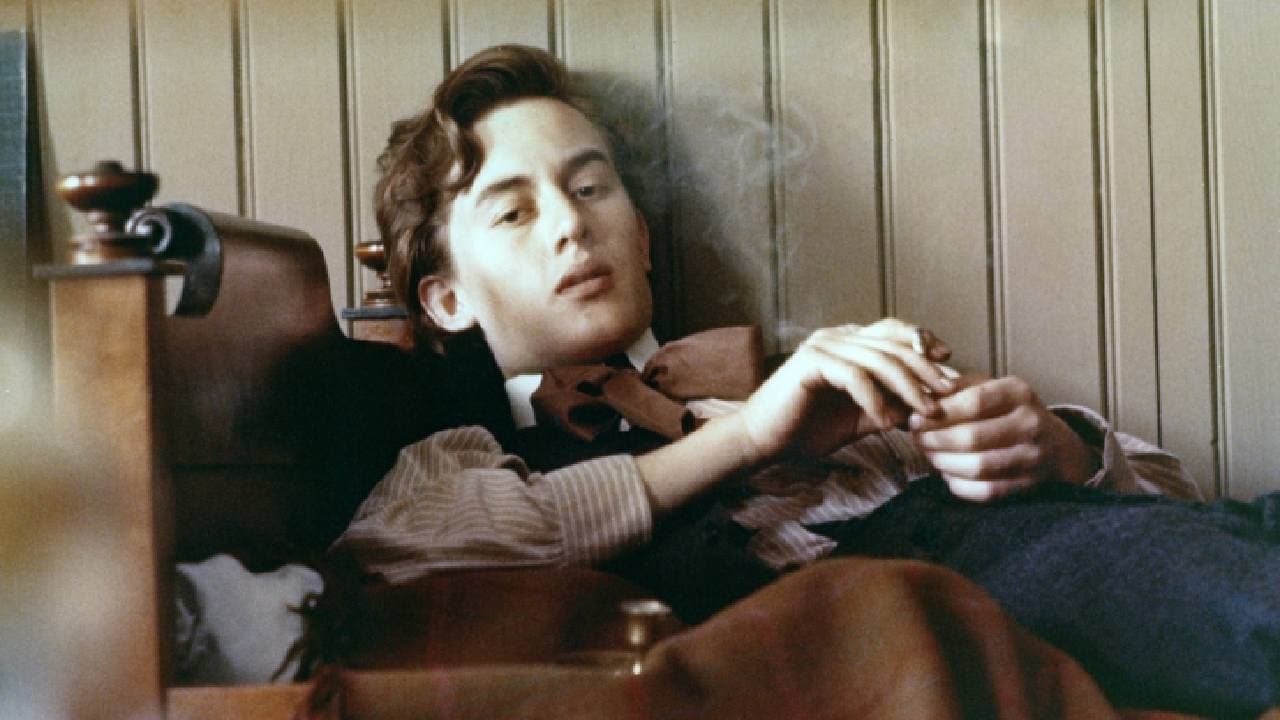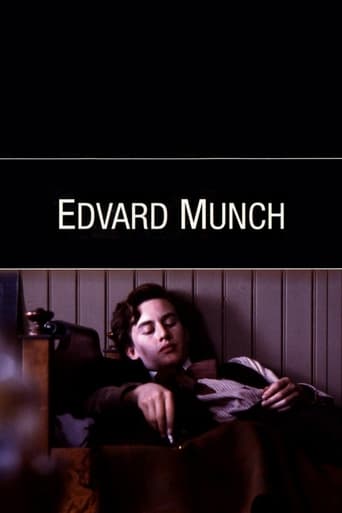

It's an unusual movie, giving us what I assume to be most of the details of the life and work of Edvard Munch, who was responsible for considerably more than a couple of horror movie satires.It's unusually done. I'm not sure I've seen another quite like it. I was unable to sit through the whole movie because, let's face facts, ars longa, vita brevis. Munch grew up in Kristiania, the capital of Norway at the time, and belonged to a class that I think is called shabby genteel. Religious observances were strict and tuberculosis was ubiquitous. Post-puberty, he joined a local group of intellectuals, "the Bohemians," where art and Marxism were common topics. The first painting he produced was of his sister dressed in black. The narration tells us it "drew scorn" but I don't know why. The painting we see in the film isn't an exact replica of the original but both look pretty good to me. (I speak to you as your art expert. Fee: 1 kr.) It reminded me of Bergman's "Scenes From a Marriage." It's really slow. The growing up is slow. The bedding of Mrs. Hager seems to take as long as the Old Stone Age. There are many choker close ups of ordinary faces, mostly just glancing at one another or, sometimes, the camera. Little attention is paid to the fourth wall. Geir Westby, who plays Munch, bears a remarkable resemblance to the model. He has a sweet, shy face with lips that are a little too full. The other actors fit the roles and they're all quite good. Westby in particular does a good job with a demanding part.I found it a little hard to follow. The narration doesn't always match was we're seeing on screen. There are time shifts back and forth. There's a good deal of attention paid to kissing on the neck, a practice that evidently appealed to Munch and was to generate all those etching of vampires. As a matter of fact, I have a postcard of one of those etchings tacked on my wall as we speak. I'm very proud of it. It was stolen from the National Gallery in Washington.Now, if you think because of that last peregrination about a postcard, that I'm confusing you, wait until you watch this movie. And remember, let us not judge others too harshly. Those with peccadilloes should not throw stones.
... View MoreEnglish screenwriter, film editor and director Peter Watkins' documentary drama which he wrote with the actors, was screened Out of Competition at the 29th Cannes International Film Festival in 1976, was originally made as a miniseries in three parts and is a Norway-Sweden co-production. It tells the story about Norwegian painter Edvard Munch who was born in the village of Ådalsbruk in the municipality of Løten which is located in the county of Hedmark in Eastern Norway on the 12th of December in 1863. Amongst his four siblings Johanne Sophie, Inger Marie, Petter Andreas and Laura Cathrine Munch, Edvard was the second eldest of two boys and three girls who spent most of their early lives in the, at that time, capital of Norway. In Christiania which was politically conservative, protestant by religion and where most of the inhabitants was middle-class, the children of former housemaid Laura Cathrine Bjølstad/Munch and family supporter Christian Munch often had to move around from one crowded house to another in the poorer districts of Christiania due to their father's medical practice. In the early 1880s when he made his first self-portrait and studied under Norwegian naturalist painter and journalist Christian Krogh (1852-1925), Edvard joined a cultural movement called the Christiania Bohemians, a small group of radical writers and artists who emphasized the virtue of human emotions and protested against the existing order. This minority of young naturalists was fronted by their spokesman Hans Jæger, a writer and anarchist who became Edvard's friend. Edvard who as his siblings had been marred by a strict religious upbringing and much illness in the family, did not have a good relationship with his Christian father, and his association with this man whom his father naturally detested increased their estrangement. During his time with the bohemians, he met a 24-year-old woman named Andrea Fredrikke Emilie. Distinctly and subtly directed by English documentary filmmaker Peter Watkins, this finely paced biographical late 19th century period piece which is narrated by, amongst others, the director, painter Oda Lasson Krogh (1860-1935) and Edvard Munch (1863-1944) whose words and dialog derive from his diaries, draws an intimate and internal portrayal of a renowned Scandinavian artist's close relationship with his sisters, conflicting relationship with his father, amorous relationship with a married woman and struggle to express his notion of the underlying and unspoken emotional suffering that he and his family had to endure. While notable for its naturalistic milieu depictions, sterling cinematography by Norwegian cinematographer and director Odd-Geir Sæther, production design by Norwegian production designer and art director Grethe Hejer and costume design by Norwegian costume designer Ada Skolmen (1911-2006), this narrative-driven homage which examines themes like family relations, adversity, politics, gender roles, marriage, love, jealousy and art, depicts a comprehensive and reverent study of a harshly criticized and by many admired person. This historic epic about an accomplished expressionist painter who to a certain degree sacrificed love for his art and achieved worldwide acclaim with his psychological canvases which he often drew from his own experiences and in a way painted with his own soul, is impelled and reinforced by its fragmented narrative structure, rhythmic pace, numerous character portraits and love-stories, anachronistic dialog, engaging narration, interviews, the quite exceptional scenes of Edvard Munch painting and the rarely efficient acting performances by the great ensemble cast consisting of non-professional actors like Norwegian artist Geir Lederer, formerly known as Geir Westby and Norwegian painter and printmaker Gro Fraas. A cinematographic, enlightening and extraordinary documentary drama from the early 1970s which recreates essential scenes from the life of a gifted, educated and stubborn individual who influenced forthcoming 20th century expressionists, went from naturalism to modernism, from one country to another and remained true to a lifestyle that significantly affected his adulthood and his interpersonal relationships.
... View MoreVery interesting and innovative new approach of movie-making. A documentary within a biopic: Norwegian actors representing and picturing Munch, Munch's family, friends, fiends and contemporaries (speaking in Norwegian with subtitles) filmed in a journalistic way, whilst a narrator takes us through in English being sometimes Munch himself or sometimes as an instructor. The chronology of the living facts is juxtaposed by the past with a deep insight of Munch's emotional evolution and disturbances. One does learn a lot about the artist and his oeuvres. Don't expect a motion picture with a plot and you must be interested by Munch himself to be able to enjoy this throughly. Keep in mind that it's 3h30 long. Watchable for adolescents.
... View MoreThis is one of the most moving, experimental films I have ever seen. Peter Watkins' political understanding of the times and his compassion for the struggling, alienated artist is superb. He has a unique method of linking the present to the painter's traumatic past, namely the deaths of his mother and sister from tuberculosis, when he was a boy. The camerawork and close-ups of individual faces is excellent. Munch's grief, when he loses the woman he loves, leads to his best works and a premature death. No other director has made a film about the inner and outer worlds of an artist as well as this. I highly recommend the film.
... View More